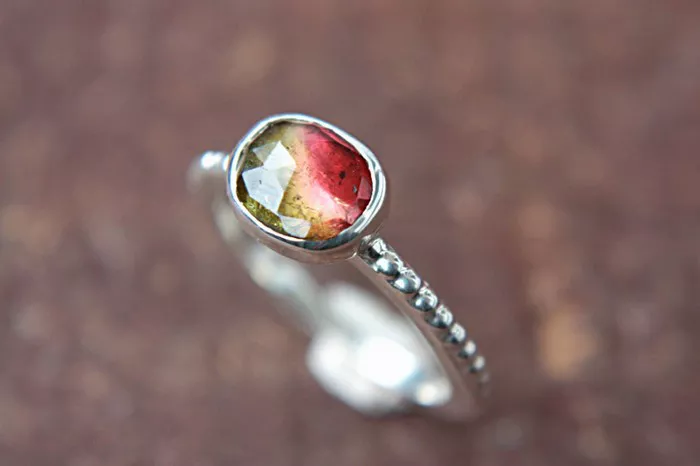Bronze tourmaline is a gemstone that captivates the imagination with its distinctive color and intriguing properties. This semi-precious stone belongs to the tourmaline family, which is renowned for its wide range of colors and unique electrical properties. Bronze tourmaline, in particular, stands out due to its metallic-like appearance and rich, earthy tones. This article aims to provide a detailed introduction to bronze tourmaline, covering its characteristics, sources, uses, and the science behind its unique properties.
Characteristics of Bronze Tourmaline
Bronze tourmaline is characterized by its distinctive metallic bronze hue, which can range from a subtle warm brown to a more vivid, almost metallic gold. This color is caused by trace elements within the crystal structure of the stone, particularly iron and titanium. The coloration can vary significantly, creating a spectrum of shades that add to the stone’s allure.
In addition to its color, bronze tourmaline is also known for its hardness and durability. With a hardness rating of 7 to 7.5 on the Mohs scale, it is relatively resistant to scratches and wear, making it a suitable choice for jewelry and decorative purposes. The stone’s vitreous luster and transparency can also vary, ranging from translucent to opaque, with some pieces displaying a chatoyancy (a cat’s-eye effect) due to parallel internal fibers.
Bronze tourmaline often occurs in elongated prismatic crystals, which can be found in a variety of geological settings. These crystals can grow to impressive sizes, though most gem-quality pieces are cut and polished to enhance their appearance and suitability for jewelry.
Sources of Bronze Tourmaline
Bronze tourmaline is found in several locations around the world, with notable deposits in Brazil, Africa, and Asia. Each source tends to produce stones with slightly different characteristics, influenced by the unique geological conditions where they are formed.
For example, Brazilian bronze tourmaline is often highly transparent with a vibrant bronze color, making it a favorite among gem collectors and jewelers. African deposits, on the other hand, may produce stones with more opaque textures and deeper, richer hues. Asian sources, such as those in China and Pakistan, also offer a range of colors and qualities, though they are not as well-known as the Brazilian and African deposits.
The mining and extraction of bronze tourmaline can be a challenging process, requiring specialized equipment and techniques to ensure the stones are extracted safely and efficiently. Once extracted, the raw crystals undergo a series of cutting and polishing processes to reveal their true beauty and potential as gemstones.
Uses of Bronze Tourmaline
Due to its unique color and durability, bronze tourmaline is a popular choice for jewelry. It can be set in gold, silver, or other precious metals to create stunning rings, earrings, necklaces, and bracelets. The stone’s warm, metallic hues complement a range of styles, from classic and elegant to bold and modern.
In addition to jewelry, bronze tourmaline is also used in decorative arts and collectibles. Carvers and sculptors appreciate the stone’s hardness and ability to take a high polish, allowing them to create intricate designs and patterns. Collectors, too, value bronze tourmaline for its rarity and beauty, often seeking out unique pieces to add to their collections.
Beyond its aesthetic appeal, bronze tourmaline is also prized for its therapeutic properties. Some believe that the stone can promote relaxation, reduce stress, and enhance overall well-being. While these claims have not been scientifically verified, the stone’s calming color and natural beauty certainly make it a soothing presence in any setting.
The Science Behind Bronze Tourmaline
Bronze tourmaline’s unique properties are the result of its complex crystal structure and chemical composition. Tourmaline belongs to the silicate mineral group, which includes a wide range of minerals formed from silicon, oxygen, and various metal ions. Bronze tourmaline, in particular, contains a mixture of boron, aluminum, silicon, oxygen, and trace elements such as iron and titanium.
This chemical composition, combined with the stone’s crystal structure, gives rise to its distinctive color and electrical properties. Tourmaline is one of the few minerals that exhibit pyroelectricity, meaning it can generate an electric charge when heated or cooled. This property is due to the alignment of positive and negative charges within the crystal structure, which changes in response to temperature changes.
Bronze tourmaline’s color is also influenced by its chemical composition. The presence of iron and titanium ions within the crystal structure absorbs certain wavelengths of light, allowing only certain colors to be reflected. This selective absorption and reflection of light is what gives bronze tourmaline its warm, metallic hue.
Furthermore, bronze tourmaline’s hardness and durability are a result of its strong crystal bonds and resistance to weathering. The silicon-oxygen tetrahedra within the crystal structure form a stable framework that resists scratching and wear, making the stone suitable for jewelry and other applications.
Conclusion
In summary, bronze tourmaline is a semi-precious gemstone that combines unique color, durability, and scientific intrigue. Its metallic-like appearance and range of shades make it a versatile choice for jewelry and decorative purposes. Understanding its characteristics, sources, uses, and the science behind its properties allows us to appreciate this gemstone even more fully. Whether you own a piece of bronze tourmaline jewelry or simply admire it from afar, this fascinating gemstone is sure to leave a lasting impression.
Related topic:
- Where Is Pink Tourmaline Most Commonly Found
- How to Cleanse Tourmaline Stone
- Who Can Wear Black Tourmaline


